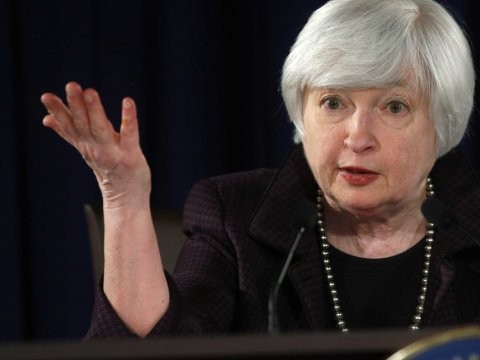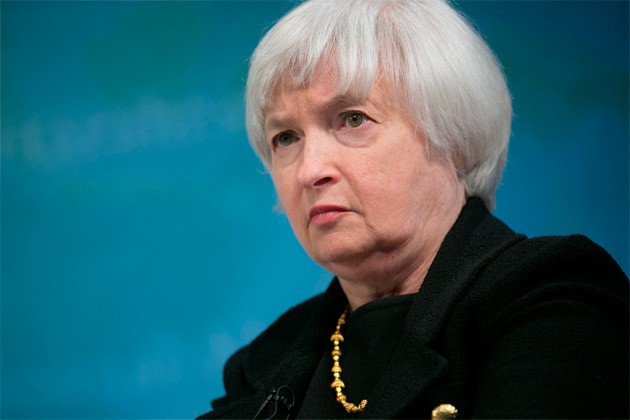Janet Yellen s Failure As Fed Chair
Post on: 29 Апрель, 2015 No Comment

Summary
- The markets are signalling deflation risk.
- The Fed’s 2% inflation target is no longer credible.
- The Fed must reverse course and resume effective monetary stimulus.
- The outlook for stocks and bonds remain bullish, with stocks being particularly attractive.
The ongoing decline in inflation, expected inflation and bond yields provides clear evidence of the failure of Janet Yellen’s chairmanship of the Federal Reserve. When she became chairman one year ago, the 10 year yield was 3%; today it is 1.9%, a decline of 37%. Ten year expected inflation was 2.3% (above the Fed’s 2% target); today it is 1.6%, far below the Fed’s inflation target. Under Yellen’s leadership the Fed’s inflation target has lost credibility in the bond market, which now believes that the rate of inflation will remain below target for the next decade.
The CRB index is down by 30% since June.
The PPI is in negative territory.
Core PCE is about to go negative.
I don’t care what Yellen thinks about economics, just as I didn’t care what Bernanke thought. I care about the seriousness of the FOMC’s commitment to meeting its 2% inflation target, and to anchor expected inflation at 2% or above as stated in its Policy Statement of January 2014:
The Committee reaffirms its judgment that inflation at the rate of 2 percent, as measured by the annual change in the price index for personal consumption expenditures, is most consistent over the longer run with the Federal Reserve’s statutory mandate. Communicating this inflation goal clearly to the public helps keep longer-term inflation expectations firmly anchored.
Clearly this target is not being met, at great danger to the economy’s long-term growth trajectory.
As I have written before, the problem with the leadership of Bernanke and Yellen is their excessive emphasis on consensus with a minimum level of dissenters. By reaching for consensus, they have given the Austrians an effective veto over unconventional policy. And conventional policy hasn’t worked.
There are two ways to fix this problem. One is to be like Greenspan and be autocratic. The other is to be like the Chief Justice and go for a simple majority, allowing the dissenters to dissent. Yes, there are drawbacks to both approaches, but the job of Fed chair is not popularity but policy success, which Yellen is not achieving. She is risking the Japanification of the US economy: a permanently stalled economy operating far below its potential growth rate.
The FOMC blathers on about its data-dependency, which is not true. In fact, the FOMC is path-dependent, because path stability supposedly lends to greater credibility. It is time that the committee wakes up and becomes data-dependent, which will require a 180 degree change in course. When the dashboard is flashing DEFLATION, it is not the time to tighten policy or to threaten to tighten it. Admit the truth: QE was ended prematurely, and the talk of a rate rise in 2015 was reckless.
To reverse the steady decline in inflation expectations will require a program of shock-and-awe that would convince the market that the Fed will do whatever it takes to restore inflation expectations to a level above 2%. Such a policy should include:

An inflation target of 3% to be maintained until inflation expectations rise to the desired level.
A statement by the committee that until inflation expectations return to the desired level, below-target unemployment and overheating will not be a concern (just as above-target unemployment is not a concern when inflation is too high).
A zero remuneration rate on excess reserves, and the explicit possibility of a negative rate.
A resumption of asset purchases at a monthly rate of $100 billion to be continued until expected inflation exceeds 2% at both the 5 and 10 year horizons. (Five year expected inflation is now 1.4%.)
A wider range of policy instruments to include a trade-weighted basket of foreign government bonds, gold, silver and ETFs.
A personal commitment from the chairman to raise inflation expectations, with the implicit threat of resignation if outvoted.
Continuation of the ZIRP until the above goals are achieved.
I think that such a program of shock-and-awe would raise inflation, expected inflation and bond yields. If it proved insufficient, more should be done with respect to both the scale of asset purchases and the variety of policy instruments. The point is to do what it takes, not just to do something and then throw up your hands as Draghi has done.
Unfortunately, the likelihood of the FOMC adopting a policy along the lines suggested above is very low. As the Fed’s credibility continues to fall, the reversibility of the decline in expectations becomes increasingly difficult, as Japan has shown since the introduction of QE, and as Bernanke warned in his famous Helicopter Speech. I am worried about the US following Japan and Europe down the road of a Fisherian problem.
Investment Implications
Bonds: Disinflation is bullish for bonds, as we have seen, with bonds having outperformed every asset class in 2014. Given my outlook for inflation, and given bond yields in Japan and Europe, US bond yields still have a long way to fall.
Stocks: The decline in the risk-free rate, ceteris paribus, widens the equity risk premium and makes stocks more attractive than alternative investments (bonds, cash, metals). It is undeniable that falling commodity prices will hurt the reported earnings of commodity producers such as oil & gas. I expect to see a lot of noncash impairment charges in the 4th quarter due to the writedown of intangibles, which may depress reported earnings (but not cashflow).
However, I don’t see the risk of a material decline in the long-term expected return from US equities which should remain where it has been for the past fifteen years at around 8% (even during the Crash). Thus, the risk free rate will decline while the expected equity return should not. A decline into an uncontrolled deflationary spiral would be devastating for stock prices, as we saw in the early Thirties, in Japan in the Nineties and soon enough in Europe, but even this do-nothing Fed would step in to prevent that. There are no Germans on the FOMC, for which we can all be thankful.
While I expect bond yields to fall further, I feel safer holding an instrument with an 8% expected return rather than one with a fixed coupon of a negligible amount. It is worth noting that the current dividend yield of the S&P 500 exceeds the yield for both the five and ten year T-bonds. We saw this briefly post-Crash, but the last time prior to that was 1956, a very good time to buy stocks assuming a long investment-horizon.
Disclosure: The author has no positions in any stocks mentioned, and no plans to initiate any positions within the next 72 hours. (More. ) The author wrote this article themselves, and it expresses their own opinions. The author is not receiving compensation for it. The author has no business relationship with any company whose stock is mentioned in this article.














